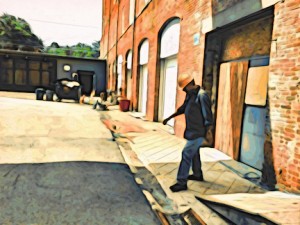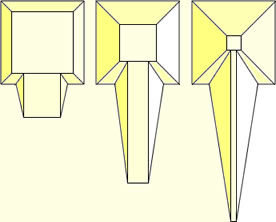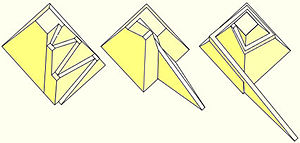You know the first thing I see when I Google “ramps”? (Ignoring those constant ads, of course). A Wikipedia article on ramps. It’s a pretty well researched and detailed article, too, listing all sorts of uses for ramps, their discovery and history, even festivals dedicated to them!
The only problem, though, isn’t about inclined planes. It’s about a plant. Specifically: Allium tricoccum, also known as wild leeks.
So when you Google one of the most important inventions in human history—one of the basic simple machines that makes civilization work—you get a smelly weed that some people like to eat. Maybe it’s just me: I think the invention that allowed us to build the pyramids is a little more important than a backyard pest that makes food smell like old socks.
At least if you search on Wikipedia itself, inclined planes are the first thing to pop up. Whoever runs that site seems to know what they’re doing, unlike those culinary-minded dudes at Google. It’s all that time inside, I’m telling you. It’s not healthy. You need fresh air and sunlight every day, so you don’t end up drooling over random greenery from your yard.
 And no, this rant wasn’t inspired by the new diet Maggie is putting me on. It’s a legitimate complaint. I mean, I don’t mind cutting back on red meat even more. I like fish and poultry just fine. I hardly drink more than a beer or two anymore, and I’ve been watching my cholesterol since my bypass 15 years ago.
And no, this rant wasn’t inspired by the new diet Maggie is putting me on. It’s a legitimate complaint. I mean, I don’t mind cutting back on red meat even more. I like fish and poultry just fine. I hardly drink more than a beer or two anymore, and I’ve been watching my cholesterol since my bypass 15 years ago.
I really just think that it’s not going to hurt me to eat proper vegetables you find in the grocery store, not expensive health food store stuff I could pull out of my neighbor’s yard. (The one without the dogs, at least. Nice dogs, but I’m not eating anything out of that yard.)
That’s not the point, though. I just think that Google is doing inclined planes a real disservice.

 The Aztecs were real tricky to find stuff on. Almost every supposed “source” detailing its construction techniques immediately starts going on about how they sacrificed people during construction, then doesn’t bother to actually discuss the techniques they used. I’m no trained historian, but that seems like sensationalism to me, and it sure doesn’t answer my questions.
The Aztecs were real tricky to find stuff on. Almost every supposed “source” detailing its construction techniques immediately starts going on about how they sacrificed people during construction, then doesn’t bother to actually discuss the techniques they used. I’m no trained historian, but that seems like sensationalism to me, and it sure doesn’t answer my questions. The Incans were the easiest to find information on, since most of the stuff on the Internet is about their construction techniques anyhow. Their buildings were famed for being constructed of huge stone blocks in irregular patterns that for together perfectly, without gaps. You can’t even stick a knife between the stones.
The Incans were the easiest to find information on, since most of the stuff on the Internet is about their construction techniques anyhow. Their buildings were famed for being constructed of huge stone blocks in irregular patterns that for together perfectly, without gaps. You can’t even stick a knife between the stones. I had a brand new Schwinn, and he had one of those heavy black Raleigh bikes from England. The boards were resting on the cinder block at about a 45-degree angle. I went first, on account of John being quite a bit smarter than me. I moved right up against his house to get the fastest start I could. I came at the ramp straight on and made it onto the board I was aiming at, which then promptly broke in half, and I crashed full speed into the cinder blocks.
I had a brand new Schwinn, and he had one of those heavy black Raleigh bikes from England. The boards were resting on the cinder block at about a 45-degree angle. I went first, on account of John being quite a bit smarter than me. I moved right up against his house to get the fastest start I could. I came at the ramp straight on and made it onto the board I was aiming at, which then promptly broke in half, and I crashed full speed into the cinder blocks. John, meanwhile, hadn’t bothered to watch me go down. When he saw me ramp, he just had to go himself. He used a different, longer board than I did. As soon as his back wheel hit the end of the board, it flipped up into the air like it were part of a catapult, flew through the air, and somehow managed to land on one end on my injured arm between the wrist and elbow, breaking it a second time before bouncing farther down the hill.
John, meanwhile, hadn’t bothered to watch me go down. When he saw me ramp, he just had to go himself. He used a different, longer board than I did. As soon as his back wheel hit the end of the board, it flipped up into the air like it were part of a catapult, flew through the air, and somehow managed to land on one end on my injured arm between the wrist and elbow, breaking it a second time before bouncing farther down the hill. The ancient Egyptians obviously didn’t have the technology for moving heavy loads that we did. All they had were a few primitive cranes, some basic levers and rollers, and, of course, ramps.
The ancient Egyptians obviously didn’t have the technology for moving heavy loads that we did. All they had were a few primitive cranes, some basic levers and rollers, and, of course, ramps. It seems more likely that they instead either zigzagged the ramp up one side or spiraled it around the pyramid, using uncompleted segments as the ramp. This would have allowed them to construct the vast majority of the pyramid easily, though the top third of the structure would have needed to be moved up, using levers. Since it’s so much narrower at the top, though, that top third makes up less than five percent of the total weight of the pyramid. That’s working smart.
It seems more likely that they instead either zigzagged the ramp up one side or spiraled it around the pyramid, using uncompleted segments as the ramp. This would have allowed them to construct the vast majority of the pyramid easily, though the top third of the structure would have needed to be moved up, using levers. Since it’s so much narrower at the top, though, that top third makes up less than five percent of the total weight of the pyramid. That’s working smart.